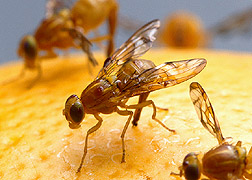This page has been archived and is being provided for reference purposes only. The page is no longer being updated, and therefore, links on the page may be invalid.
|
|
|
|
For Best Pest Detection, Suit the Attractant to the Fruit Fly
By Alfredo FloresJanuary 18, 2008
Several Anastrepha fruit fly species that plague Latin American fruit growers are also quarantine pests in the United States. To evaluate lures used to monitor fruit flies in production areas, Agricultural Research Service (ARS) scientists and colleagues in the Dominican Republic recently tested two ammonia-based formulations and found them to differ in effectiveness, depending on the Anastrepha species.
Synthetic lures rely on the attractiveness of protein sources to catch hungry fruit flies. One commercial attractant—Biolure, made by Suterra LLC of Bend, Ore.—includes ammonium acetate and putrescine among its components. Entomologist Nancy Epsky at the ARS Subtropical Horticultural Research Station in Miami, Fla., tested the effect of ammonia formulation, substituting ammonium biocarbonate for the ammonium acetate.
Using Multilure traps, Epsky tested both ammonia formulations—at different release rates in combination with putrescine—on wild fruit flies. Collaborators at the Instituto Dominicano de Investigaciones Agropecuarias y Forestales in San Francisco de Macorís, Dominican Republic, assisted with the testing.
Traps were deployed at study sites with active populations of Mexican fruit flies (A. ludens) at Allende and Linares in Nuevo Leon, Mexico; Caribbean fruit flies (A. suspensa) near Fort Pierce, Fla.; and West Indian fruit flies (A. obliqua) at Hato Damas in the Dominican Republic. Researchers tested six treatments, including two standard liquid protein baits and four synthetic lure combinations, for periods of eight to 16 weeks, replacing the synthetic lures after four weeks.
At both Mexican sites, traps with the ammonium acetate-putrescine combination captured more Mexflies than all of the other attractants, and the ammonium biocarbonate-putrescine combination performed better than protein-baited traps. The ammonium acetate-putrescine combination also worked better with Caribflies at the Florida test site.
But with West Indian fruit flies in the Dominican Republic, protein baits outperformed both synthetic baits, although ammonium acetate again proved more attractive than ammonium bicarbonate.
While one lure combination will not be optimal for all species and all regions where fruit flies are pests, these results showed what works best in the locations tested. The findings were reported at a recent meeting of the Entomological Society of America.
ARS is the U.S. Department of Agriculture’s chief scientific research agency.

